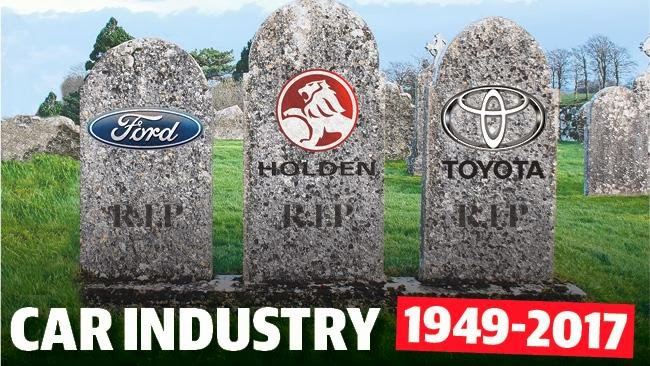The Core of The Australian Working Class
Written by: on
The decision by the multinational corporations to close down the car industry, tyre industry, whitegoods industry and others in Australia struck at the core of the working class.
The Australian Communist 2010 described the core of the working class (proletariat) in the following way:
The Australian Communist 2010 described the core of the working class (proletariat) in the following way:
"The Australian proletariat consists of industrial workers and rural workers who have 'nothing to sell but their labour power.' In the factories, workshops, mines, construction sites, transport systems and farms, their labour creates 'surplus value' that is expropriated by the owner(s) of each productive enterprise and the capitalist class as a whole. Profit is realised when the value-added products are sold, and pocketed by the capitalist/imperialist owner(s) individually and as a class."
The extent of the decline in manufacturing in the last 30 years has led some good people to think that the 'class war' is now over due to the structural changes in the economy and that there is no longer a significant industrial working class with the strength to be the leading force in the struggle against capitalism/imperialism in Australia.
It is true that the manufacturing workforce declined from 17% of the total Australian workforce in 1985 to 7% in 2017 according to ABS figures.
However an article by Bernard Salt, managing director of a company Demographics Group, in The Weekend Australian cites ABS data that show that the core of the working class (the proletariat) is still a strong force both numerically and in terms of its leading role in the class struggle in Australia. Below are some facts about the industrial workers in Australia taken from Salt's article:
* Australian manufacturing accounts for 877,000 jobs directly engaged in the process of production
* 25,000 of the 877,000 have post graduate qualifications.
* Manufacturing jobs in capital cities are still concentrated geographically speaking.
17,000 in Dandenong in Melbourne
9,000 in Campbellfield and Coolaroo in Melbourne's north
5,000 jobs in Wetherill Park in Sydney
5,000 jobs in the north west suburbs of Adelaide in the Port area
5,000 jobs in Rocklea , Brisbane
3,000 jobs in Malaga near Mirrabooka in Perth
17,000 in Dandenong in Melbourne
9,000 in Campbellfield and Coolaroo in Melbourne's north
5,000 jobs in Wetherill Park in Sydney
5,000 jobs in the north west suburbs of Adelaide in the Port area
5,000 jobs in Rocklea , Brisbane
3,000 jobs in Malaga near Mirrabooka in Perth
* Manufacturing jobs in regional areas are the main employers in key country towns
7,000 jobs in Barossa Valley towns of Nuriootpa and Angaston: Berri, Renmark in the Riverland: Clare in the mid north of SA, Coonawarra in the south east of SA
20% of the workforce in Griffith, 19% of the workforce in Colac, 17% in Portland NSW and 16% in Whyalla
7,000 jobs in Barossa Valley towns of Nuriootpa and Angaston: Berri, Renmark in the Riverland: Clare in the mid north of SA, Coonawarra in the south east of SA
20% of the workforce in Griffith, 19% of the workforce in Colac, 17% in Portland NSW and 16% in Whyalla
These regional towns process and add value to rice, timber, wine, steel, alumina.
* Bread manufacturing (factory based) employs 24,000
*Meat processing employs 29,000
*Poultry processing employs 13,500
* Other manufacturing industries where production line jobs have increased between 2011 and 2016 are breweries, log saw milling, and spirit manufacturing.
*Meat processing employs 29,000
*Poultry processing employs 13,500
* Other manufacturing industries where production line jobs have increased between 2011 and 2016 are breweries, log saw milling, and spirit manufacturing.
These workers are in the front line of the struggle for an independent and socialist Australia as the factories they work in are owned by multinational corporations. As Bernard Salt says, “Many of our manufacturing skills and markets are being disrupted by powerful new global forces. A strong manufacturing industry is essential if we want to project to the next generation bold ideas such as the preservation of our independence and the cultivation of a culture of technical ingenuity. Making Australia make things is good for all Australians, now and in the future".
Bernard Salt can even see the importance of "independence" from "powerful new global forces". He emphasises "preservation" with respect to independence. Preservation yes, but more importantly winning real independence from the "powerful new global forces". The core manufacturing working class is the force can than lead this struggle and as Bernard Salt's article reveals, it is still a powerful force
Print Version - new window Email article
-----
Go back
Class Struggle and Socialism
Independence from Imperialism
People's Rights & Liberties
Community and Environment
Marxism Today
International
Independence from Imperialism
People's Rights & Liberties
Community and Environment
Marxism Today
International
Articles
| Productivity: of what? from whom? for whom? |
| Drought |
| The Not-So Curious Incident of Low Wages Growth - Peetz report |
| Book Review: The Invisible Doctrine - The Secret History of Neoliberalism (& How it Came to Control Your Life) |
| Inflation hits Interest Rate Relief: The Crisis Grows! |
| Budget exposes myth of falling profitability and productivity |
| “Australian” companies that serve foreign capital |
| A suitable cause for alarm: what about the levers of power? |
| Profits - a system of economic crises, hardships and war |
| Book Review: Rent |
| Profits, Wages and Conditions |
| Bold Resistance grows to Corporates’ Economic Crisis and War |
| Agribusinesses Still Dominate Australia's Agriculture |
| Capitalism Develops and Expands in Ironic Ways |
| A bean-feast in the making: stimulus packages and the global economy |
| Climate change: Beware green swans with fat tails! |
| Uber |
| Marxism Today: The unfairness of a “fair day’s pay” |
| Reserve Army of Labour |
| BONDS |
-----

